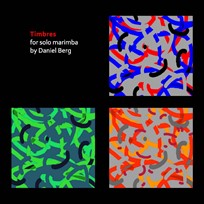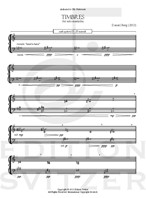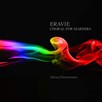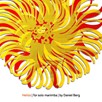Item details
-
Description +
-
Duration: 8 min.
Recently, I was invited for lunch by my good friend, artist Bengt Berglund. After lunch Bengt showed me a new work of art in different colours and said “Daniel, what kind of music will there be for these art works?”When I see the pictures I think of shapes that changes, like clouds in the sky. Even if you think you know how the cloud will be formed, it often takes a different and an unexpected direction. Different eyes also create its own interpretation of abstract forms – you choose what you associate the shapes with.
When I got home and saw the pictures again, I got an idea to write a piece with long chord changes, where listeners does not know what the ending will be – even if they have heard the music before. The piece has three different endings and each performer can decide his or her choice of ending. It may depend on the hall and the audience atmosphere in the hall for the performer to decide which ending they choose.
-
-
Instrumentation +
-
Marimba
-
-
Watch+
-
About the composer +
-
Daniel Berg is a Swedish composer, musician, and professor in classical percussion at the Royal College of Music in Stockholm and at the Academy of music and drama in Gothenburg.
In his passion to promote the marimba as a solo- and chamber music instrument, Daniel has worked intimately with a number of composers who have written original music for the instrument. This includes more than 300 world premier for solo and chamber works. Daniel Berg is a marimba artist of Bergerault and Elite Mallets.
As a composer Daniel has written a lot for solo marimba like Mistral (for Michael Burritt), Phoenix (for Robert van Sice) and Yán Jiâng (for the Taiwan World Percussion Competition). His music for percussion ensemble have been appreciated and often performed like Kroumata (for sextet) and Arctic Nights (for quintet) - all published by Edition Svitzer.
-
-
Reviews +
-
If you are familiar with Daniel Berg’s marimba works such as “Blue Memories,” “December,” “Fantasia & Toccata” and others, you may expect a rather impressionistic style with much rhythmic vitality. “Timbres” is different. Written exclusively with whole-note chords to be rolled hand-to-hand with flexibility in note length, the dynamic scheme predominates in the niente to p range with a few larger swells. Most chords are in very closed voicing with tension and release both dynamically and harmonically. The work has three optional endings that each require independent rolls, and the performance available on the composer’s website is six minutes in length.
As with many of Berg’s works, the inspiration comes from the visual arts—in this case, a work of art in three versions of differing colors by Bengt Berglund. When visiting the artist, Berg was asked: “What kind of music will there be for these art works?” The composer states: “When I see the pictures I think of shapes that change, like clouds in the sky. Even if you think you know how the cloud will be formed, it often takes a different and an unexpected direction. Different eyes also create its own interpretation of abstract forms—you choose what you associate the shapes with.” What resulted was a work with long chords and an ending that even a listener familiar with the piece will not know as the performer has a choice that “may depend on the hall and the audience atmosphere.”
In spite of its uniqueness, the work leaves me with the same contemplative feeling of many of Berg’s other compositions. A perusal of the score sample and a recording on the above web source is well worth your time in familiarizing yourself with the piece.
—Susan Martin Tariq
-
-
Credits +
-
Front Cover graphics and layout: Ronni Kot Wenzell
Enamel painting: Bengt Berglund
Engraving: Johan Svitzer
Printed in Copenhagen, Denmark
Copyright © Edition SVITZER
www.editionsvitzer.com
-






